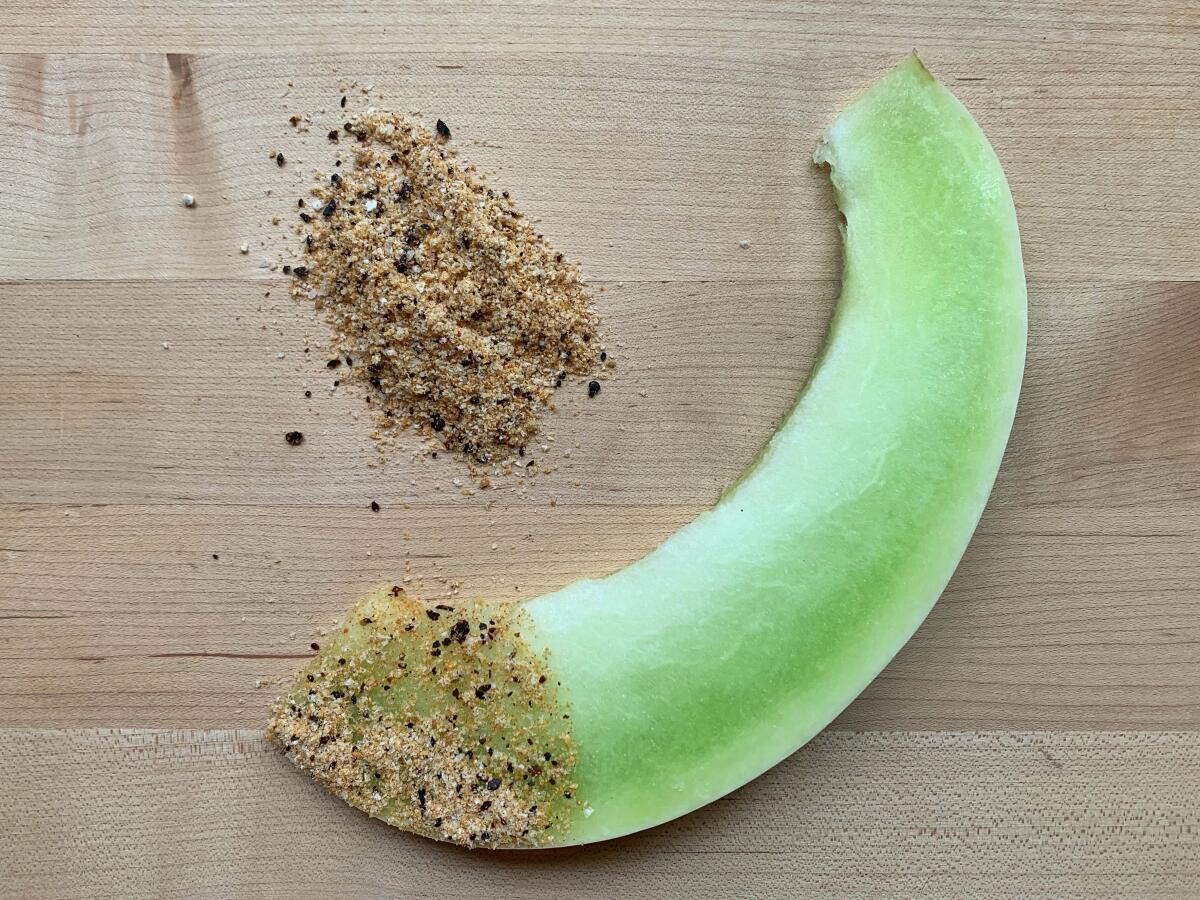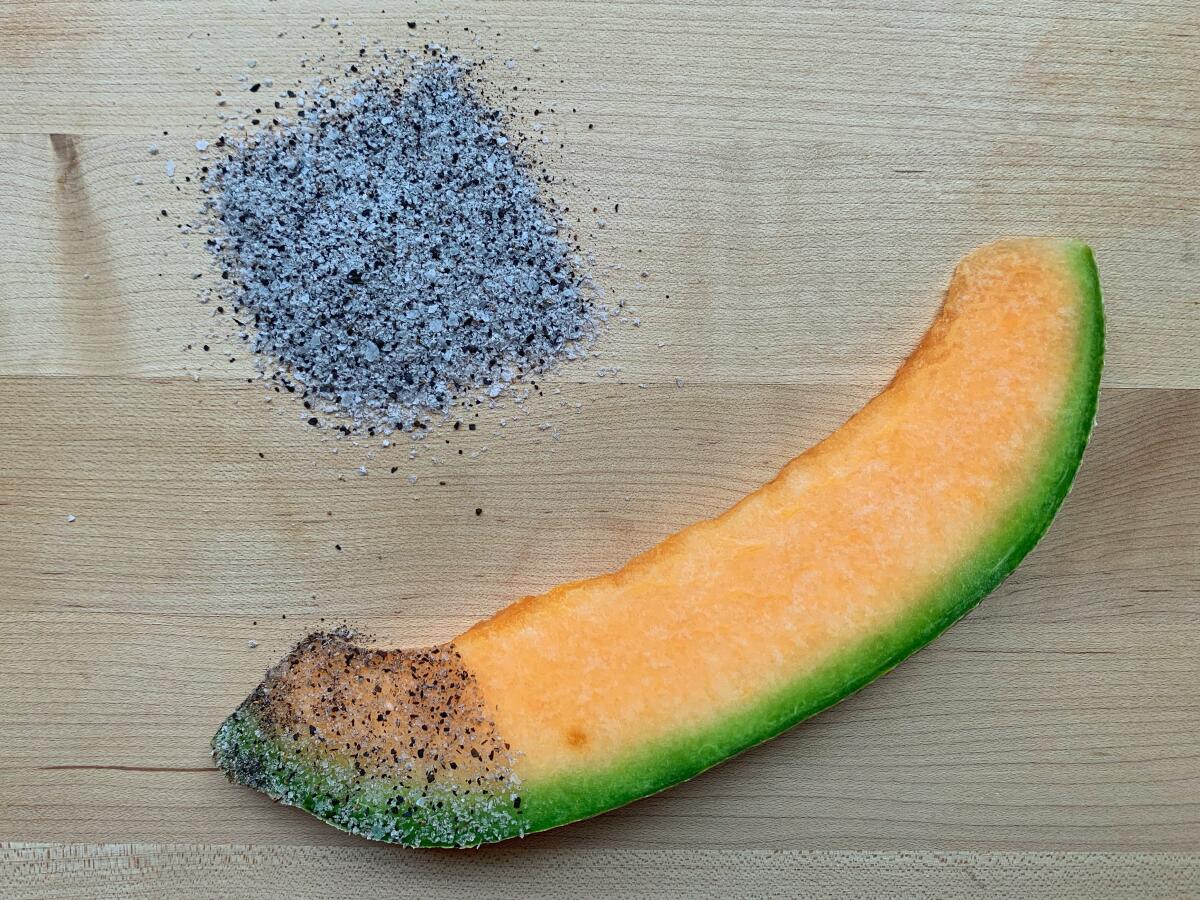Want to spruce up your salt? Add vanilla

You are reading our Cooking newsletter
Sign up to get a taste of Los Angeles — and the world — in your own home and in your inbox every Friday
You may occasionally receive promotional content from the Los Angeles Times.
Walk into any grocery store or gourmet shop and the variety of salts can be dizzying. Colorful paper boxes, large plastic tubs, palm-sized glass jars, even transportable tins for single servings of the stuff — the options and the possibilities for using them are endless.
“There is no more important ingredient in your cooking than salt, but at the same time, it’s the most argued over,” former L.A. Times Cooking columnist Ben Mims wrote in 2021. “There are dozens of brands, and each one is made using a particular process.”
If you’re anything like me, any given shop’s array is also eye-catching. Especially when it comes to seasoned salts, which beckon you to experiment by the pinch or light shake.
Science and professional chefs dictate that you should be seasoning your cooking throughout any process, and not simply at the end. The particular variety of salt — kosher, large-flake, fine sea salt — most likely will vary with your preference and the recipe at hand.
But when I’m at home simply winging it, I occasionally reach for not the usual suspects but an infused salt or a blend, something with a bit more oomph, whether I’m using it early in the cooking process or simply as a finishing salt. Flavor can easily be gained by the addition of salt and herbs or spices, but by combining them and letting them mingle for hours or days or even weeks, the tones and nuances intensify.
“Flavor always develops better over time,” says chef Sean MacDonald.
At his Santa Monica restaurants Bar Monette and Burgette, MacDonald primarily uses salts to flavor and brine or otherwise preserve ingredients, with one very special exception.
Bar Monette’s apple fritter, one of my favorite desserts I’ve tasted so far this year, gets a sweet-salty flourish thanks to a house-made vanilla salt.

MacDonald added the sticky, pillowy-interiored apple fritter to the menu as an ode to one of his late Aunt Wendy’s favorite treats. The restaurant’s chef de cuisine, Jeff Whittaker, helped develop the recipe with MacDonald and, after a windfall of a large vanilla delivery at the restaurant, decided to experiment with the salt. The fritter gets a lacquer-like coating of reduced apple trimmings and juice — a byproduct of its components — and the final sprinkling of the house-infused vanilla salt, with flavors mingling for five days, imparts a floral note: a familiar flavor delivered via an unexpected vessel.
Bar Monette’s vanilla salt infuses for roughly a week, the scraped vanilla beans and pods slowly drying in a blend of two varieties of salt. Each day the kitchen team agitates the container to ensure the vanilla is drying and distributing evenly, and because it’s used on dessert at the restaurant, a small amount of sugar is added at the end of the process.
A number of L.A. restaurants make infused salts not only for their kitchens but for yours. Gjusta’s ever-rotating selection of pantry goods currently includes multiple infused salts, such as a zesty herbed salt made with lemon, wild oregano, thyme, rosemary and chile flakes; a za’atar variety that’s also dotted with thyme and oregano; and a smoked-chile option with Aleppo pepper and lemon zest. I recently picked up a few jars during a visit to the Venice restaurant and have been dreaming of a summer spent sprinkling grilled steaks with Gjusta’s smoky salt.
For years Momofuku, the restaurant and retail empire from Majordomo’s David Chang, has sold jars of Tingly Seasoned Salt: a salt blend packed with Sichuan peppercorn, citric acid, mushroom and seaweed, among other seasonings, and one I’ve long used to coat root vegetables before tossing them in the oven. Lawry’s — essentially the world’s seasoning-salt magnate — still operates its first steakhouse right here in Beverly Hills, where the brand’s globally popular blend of 17 herbs and spices took three months to develop before its debut in 1938 and can still be found on the tabletops (and available to take home).
Another favorite I recently discovered hails from the other side of the world. Anajak Thai Cuisine and Bestia both use Saltverk in their kitchen arsenals. The Icelandic company harvests salt from the Westfjords using a sustainable geothermal process, and the substantial, crystalline pyramids carry heft and flavor. Saltverk’s Arctic-thyme salt, where sprigs, petals and thyme buds lend herbaceous, floral flavor to the flakes, is my favorite of the line. Sprinkle this one onto seafood and salads or, as the company recommends, in curing meats.
Part of the fun of seasoned salt is customization. While there is a range of infused-salt products designed to up your cooking game in L.A. and beyond, making your own batch takes little time and yields big flavor. Here are a few recipes to get you started, along with some ideas on where to use your new favorite seasoning blends.
Eating out this week? Sign up for Tasting Notes to get our restaurant experts’ insights and off-the-cuff takes on where they’re dining right now.
Bar Monette’s Vanilla Salt
Bar Monette and Burgette chefs Sean MacDonald and Jeff Whittaker shared their recipe for vanilla salt, which tops that fluffy-crunchy apple fritter in Santa Monica. It takes only a few minutes to throw together, plus five days to infuse. MacDonald recommends sprinkling this on desserts of any kind, especially chocolate tortes or cinnamon buns. It also could spruce up a batch of fresh whipped cream.
Get the recipe.
Cook time: 5 minutes, plus five days to infuse. Makes roughly ½ cup.

Sesame Salt With Coriander and Urfa Chile
Former L.A. Times cooking columnist Ben Mims created this recipe, in which urfa, whole coriander and sesame seeds add smokiness and nuttiness. Toasting the spices and seeds beforehand creates a fragrant, “mole-like flavor profile.” “I like to make combinations of spices that are earthy and tart to amp up the savoriness of the salt,” he writes. Try this sprinkled on or fully coating sliced fresh fruit, especially honeydew.
Get the recipe.
Cook time: 10 minutes, plus 2 hours or overnight to dry. Makes ⅔ cup.

Black Lime Salt With Star Anise and Cinnamon
For a more tart take on seasoned salt, Mims also penned a recipe that adds warming spices star anise and cinnamon to a blend with brightening black lime. He recommends enjoying this with fresh cantaloupe or muskmelon — as sweet as you can find.
Get the recipe.
Cook time: 10 minutes, plus 2 hours or overnight to dry. Makes ½ cup.

Enjoying this newsletter?
Consider becoming a Times subscriber.
Smoky Spiced Salt With Orange
As delicate and delightful as seasoned salts can be when used as a sprinkle in sauces or salads, their use in brining or rubbing whole birds, seafood, large steaks, pork shoulders or racks of ribs before they hit the grill or the oven can’t be overstated. This is flavor country. Former L.A. Times Food editor Russ Parsons shared a recipe for a citrusy, smoky salt blend that can be stored for two weeks and provide pops of flavor, but it’s especially used to dry-brine a 20-pound turkey at Thanksgiving. Paprika, cumin, orange zest, brown sugar and more add heft to this mélange that’s packed with spices. Give it a try at the holidays, or even sooner. After all, grilling season is here.
Get the recipe.
Cook time: Roughly 5 minutes. Makes a little more than ½ cup.
Have a cooking question?
Eat your way across L.A.
Get our weekly Tasting Notes newsletter for reviews, news and more.
You may occasionally receive promotional content from the Los Angeles Times.




